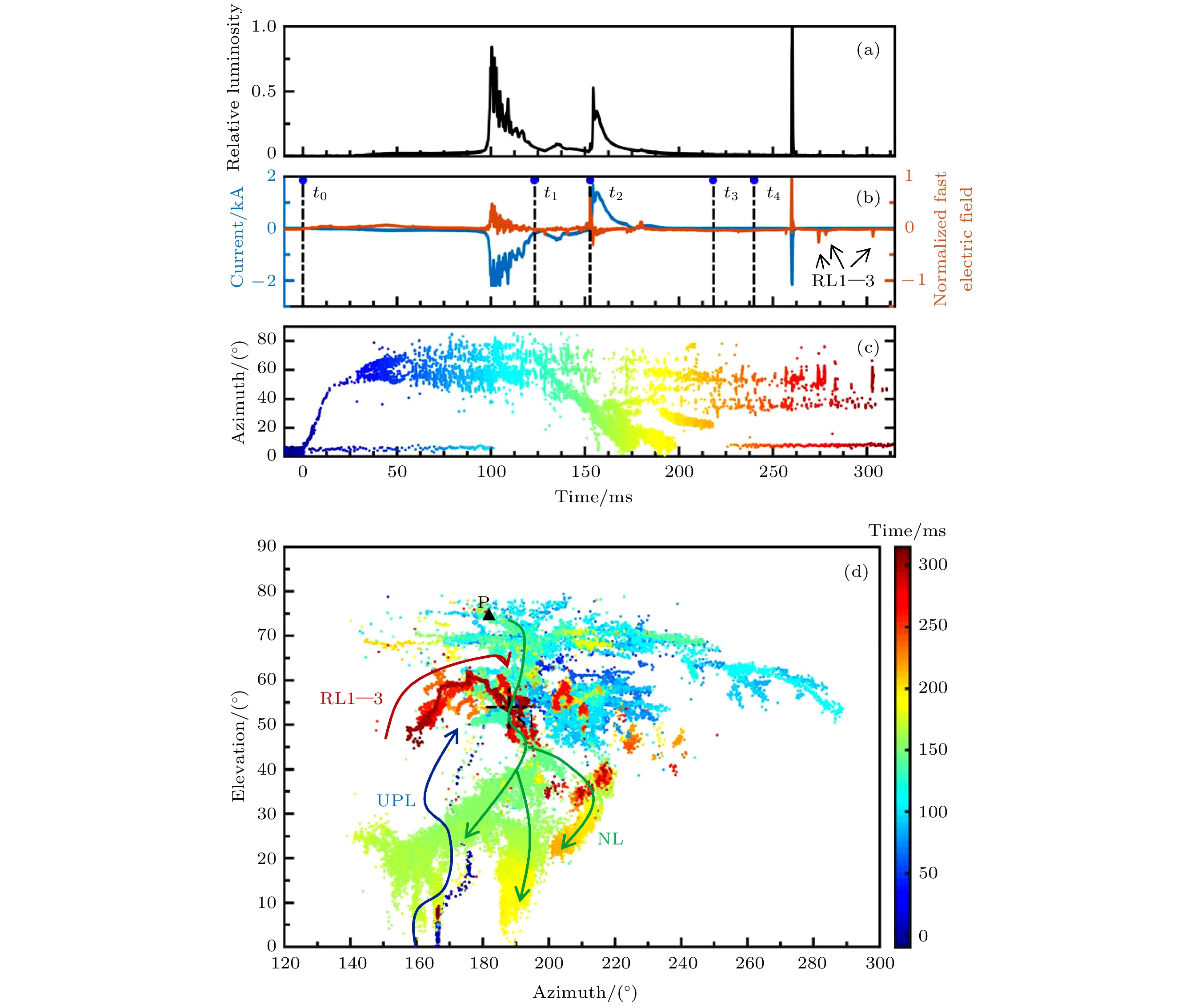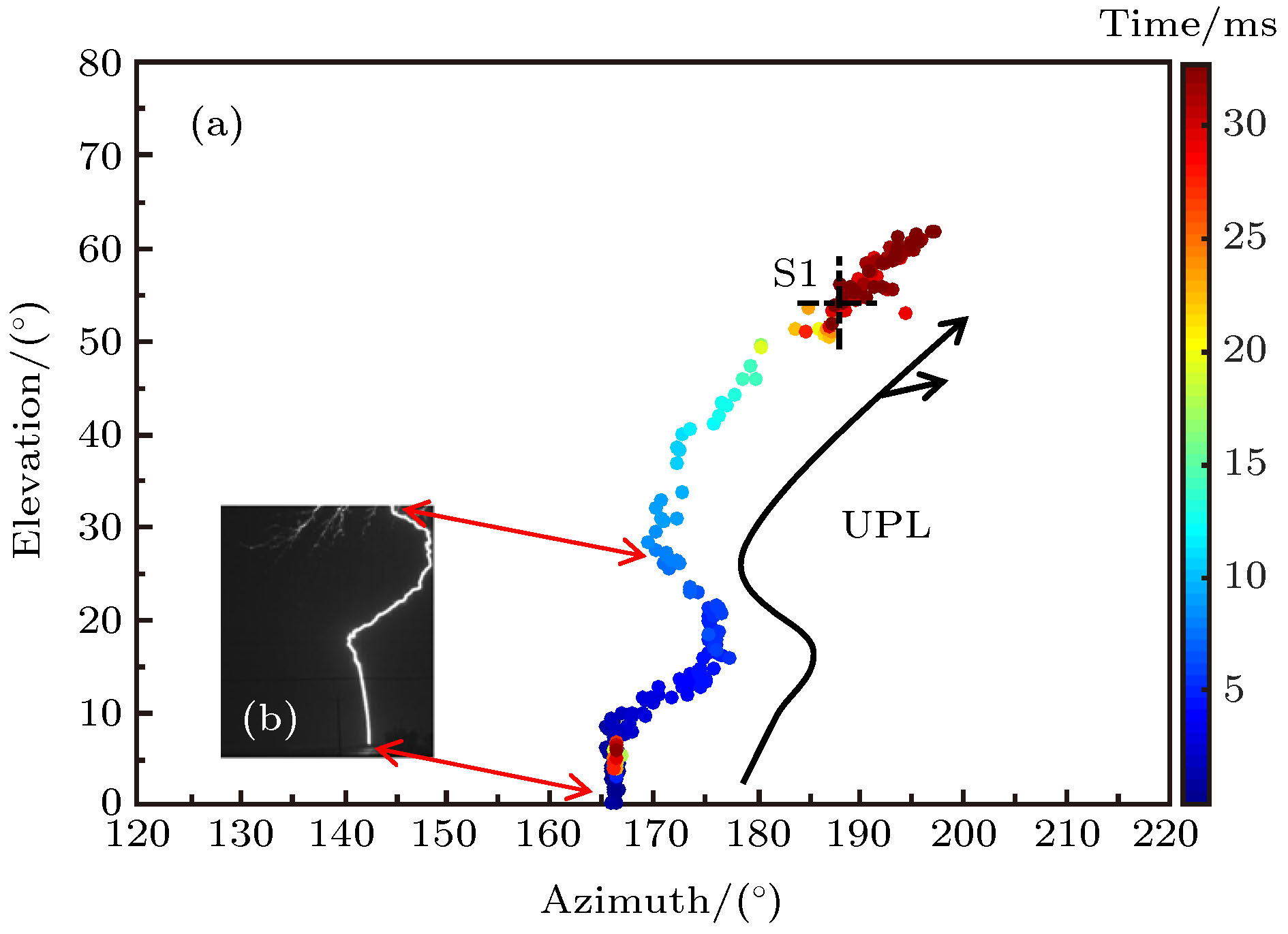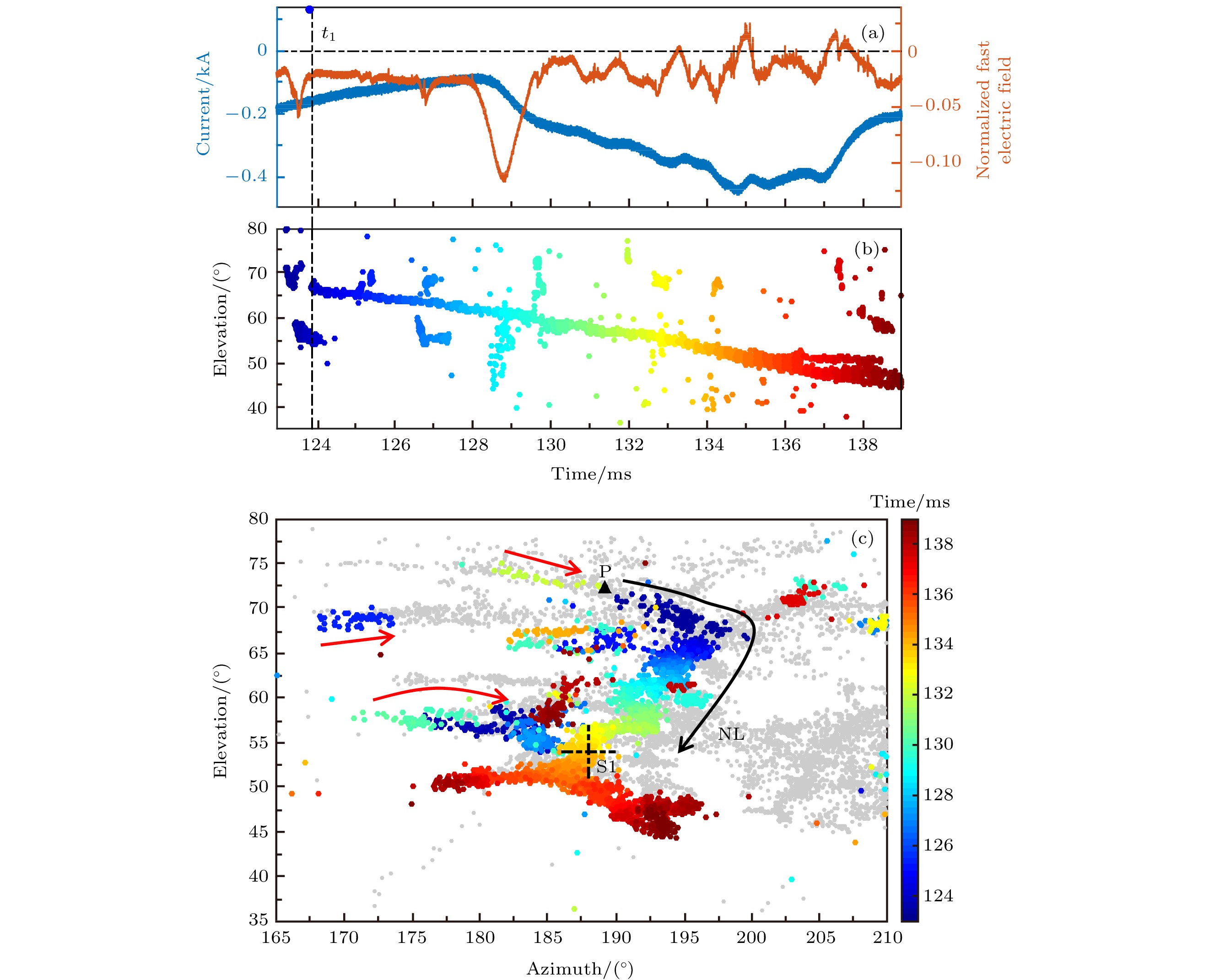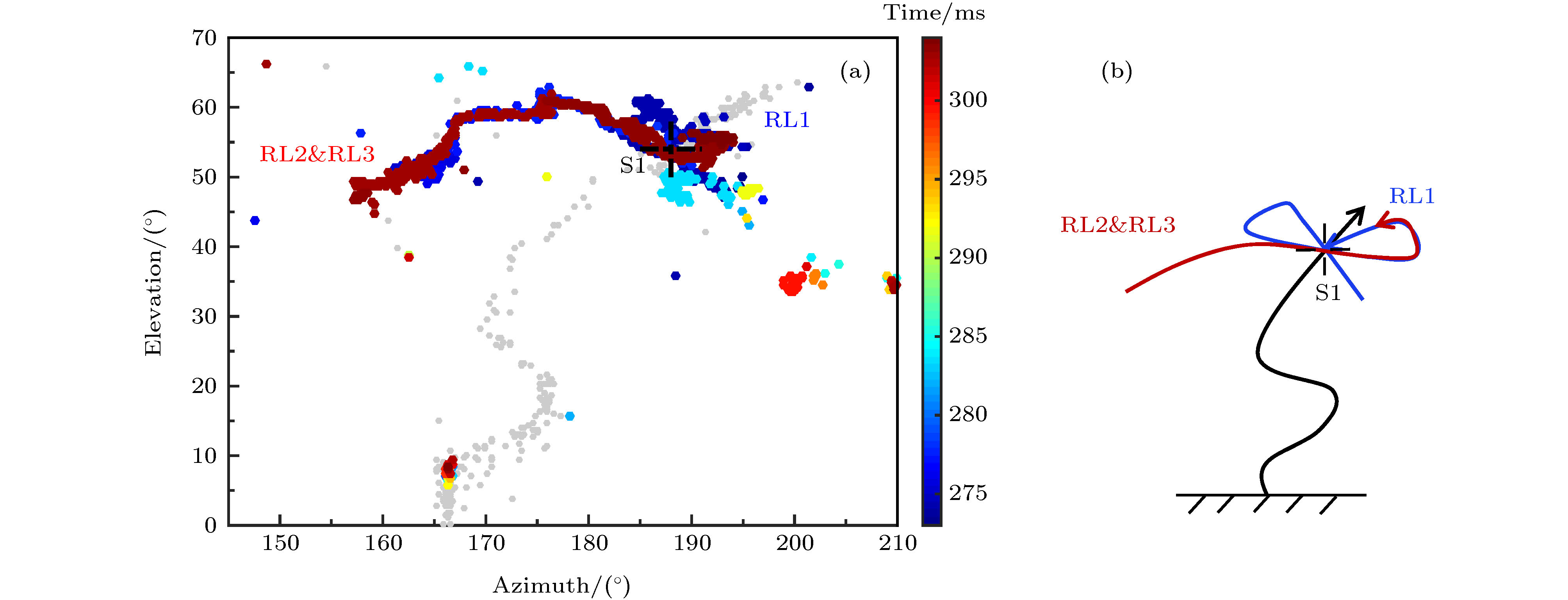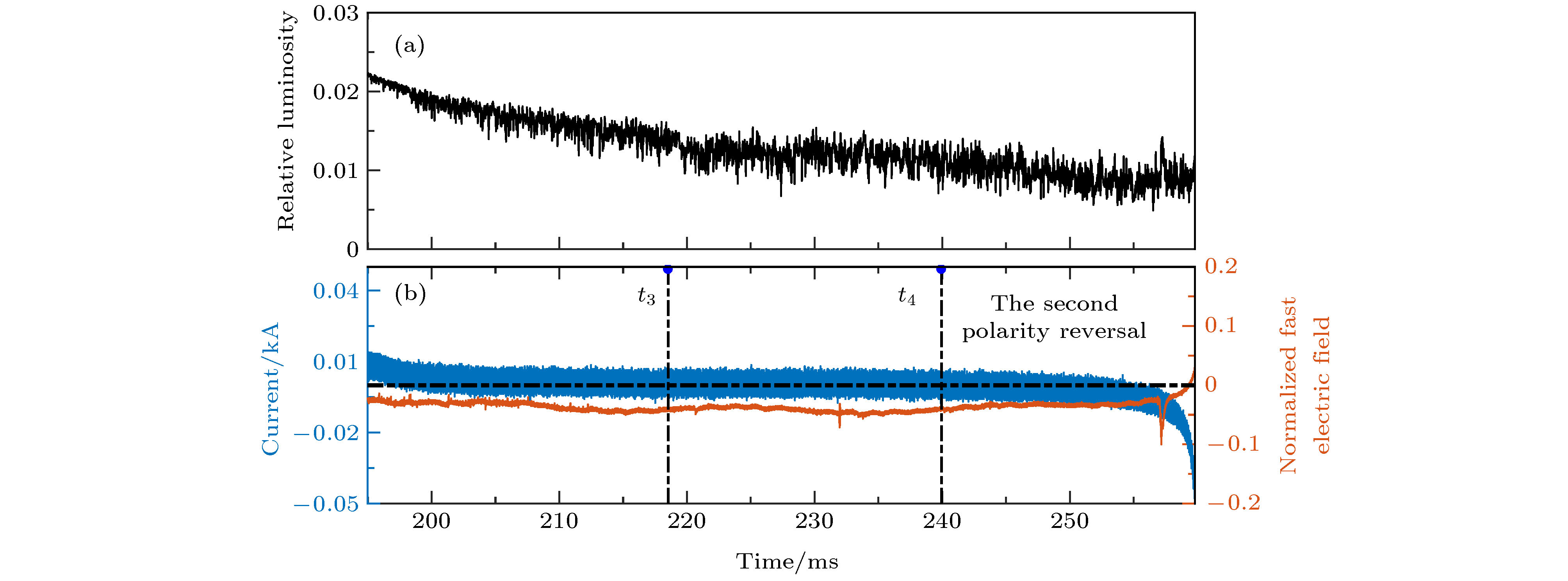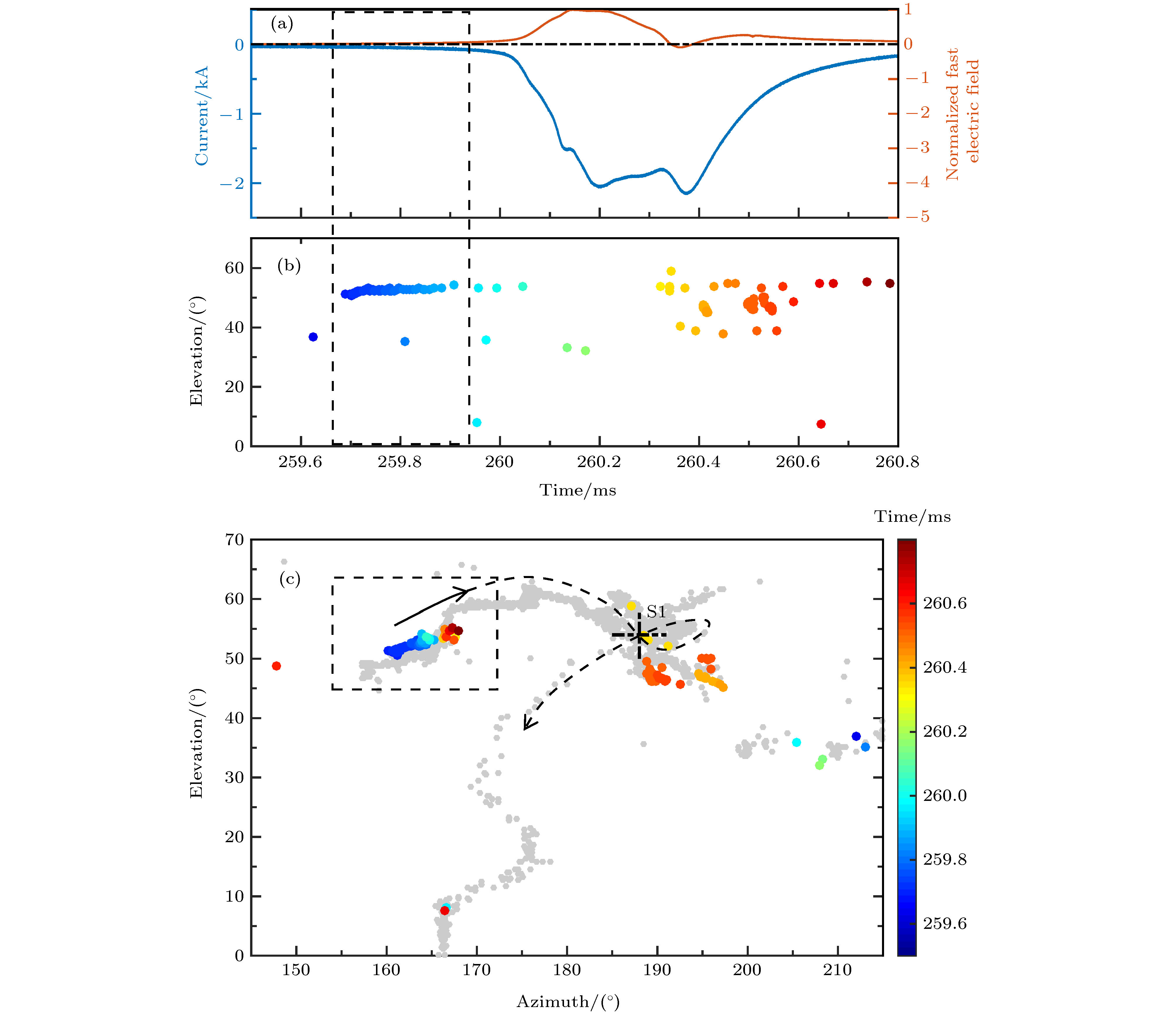-
利用闪电甚高频干涉仪动态成像结果, 并结合通道底部电流、电场和光学观测资料对一次罕见的、对地转移电荷极性反转两次的双极性人工引发雷电放电特征进行了详细研究, 首次观测到直接导致极性反转的云内击穿放电过程, 探讨了对地转移电荷极性两次反转的物理机理. 结果发现, 此次闪电无回击过程、初始连续电流阶段对地转移电荷极性经历了负-正-负的两次反转, 转移电荷量分别约–40.0 C, +13.3 C和–1.0 C. 负极性初始连续电流衰减过程中, 一支击穿空气的负先导起始于已电离的正先导分支通道上并形成悬浮通道, 水平发展28.816 ms后, 接地主通道上发生负极性击穿连接到了悬浮通道末端正电荷聚集处或双向发展的悬浮通道的正极性端, 随后对地转移电荷极性快速反转为正. 负先导熄灭后, 对地转移电荷极性缓慢反转为负. 击穿空气的负先导连接到接地主通道和持续发展的正先导是此次双极性闪电对地转移电荷极性发生两次反转的重要原因. 而负先导的起始, 与正先导多分支同时发展引起的先导通道和环境电势分布差异密切相关.Characteristics of a triggered bipolar lightning flash obtained in the Shandong triggering lightning experiment (SHATLE) are analyzed based on simultaneous observation results of lightning very high frequency (VHF) interferometer map, channel-base current, fast electric field change and high-speed optical images. The flash lasts about 315 ms with only the initial continuous current (ICC). As the polarity of charges transferred to the ground varies from negative to positive and then to negative, the ICC can be mainly divided into three stages including the first negative ICC stage, positive ICC stage, and second negative ICC stage, respectively, for 152.755 ms, 87.225 ms and 75.02 ms. Charges transferred to the ground during the three stages are about –40.0 C, +13.3 C and –1.0 C, respectively, with the peak current of about –3.8 kA, 1.6 kA and –2.25 kA. According to the VHF interferometer map, during the first negative ICC stage, the upward positive leader (UPL) initiated from the top of the wire as negative charges starts to be transferred to the ground. The UPL develops at a two-dimensional (2D) speed of 3.7 × 104 m/s into the cloud and multiple positive branches develop in the form of small-scale and dense recoil leaders, keeping the increase of negative charge transferred to the ground. Then a negative leader (NL) initiates on a previously ionized positive branch channel and develops into the virgin air horizontally as a floating channel at a 2D propagation speed of 1.59 × 105 m/s. About 28.816 ms later after the NL develops, a negative pulse is detected in the fast electric field change, caused by a negative polarity breakdown discharge from the grounding trunk channel to the floating channel which is observed for the first time. Then about 39 μs later, the first polarity of the channel-base current changes from negative to positive, and rapidly reaches a positive peak in 1.75 ms. Subsequently, with the positive ICC decreasing, the negative leader gradually terminates about 65.85 ms after the first polarity reversal, and then 21.38 ms later the channel-base current slowly changes to the recognizable negative polarity as the second polarity reversal. A recoil leader generating in a previously ionized positive branch channel connects to the trunk channel, resulting in the initial continuous current pulse (ICCP) during the second negative ICC stage. Then several negative recoil leaders occur, tracing back to the previous positive channels without obvious current changes until the flash ends. Based on the analysis, the positive branch channel persistently transfers negative charge to the ground in the whole discharge process by the positive breakdown on the tip or the negative recoil leaders retrograding along the previous positive channels. The trunk channel is connected to the floating channel through negative breakdown discharges, linking at the positive charge accumulation area at the tail end of the negative leader or the positive polar end of a bidirectional leader towards the trunk channel, if the negative leader develops as a bidirectional leader later. Then, the net charge transferred to the ground is dominantly positive and the reversal of first channel current polarity occurs. With the negative leader disappearing, the supply of positive charge ceases, so the current polarity reverses again (the second reversal). Connection of the negative leader to the grounding trunk channel and continuous development of the positive leader are inferred to play an important role in reversing the two current polarities. In this case, the negative leader developing in virgin air might be initiated transversely in an ionized positive channel or from the end of a decayed positive leader branch of the ionized positive channel which is small and undistinguishable from the VHF interferometer map.
-
Keywords:
- leader /
- bipolar lightning /
- rocket triggered lightning /
- very high frequency radiation sources location
[1] McEachron K B 1939 J. Franklin Inst. 227 149
 Google Scholar
Google Scholar
[2] Hubert P, Mouget G 1981 J. Geophys. Res. Oceans 86 5253
 Google Scholar
Google Scholar
[3] Akiyama H, Ichino K, Horii K 1985 J. Geophys. Res. Atmos. 90 10674
 Google Scholar
Google Scholar
[4] Idone V P, Orville R E, Mach D M, Rust W D 1987 Geophys. Res. Lett. 14 1150
 Google Scholar
Google Scholar
[5] Liu X S, Zhang Y J 1998 IEE J. Trans. Power Energy 118 170
 Google Scholar
Google Scholar
[6] Yoshida S, Biagi C J, Rakov V A, Hill J D, Stapleton M V, Jordan D M, Uman M A, Morimoto T, Ushio T, Kawasaki Z I, Akita M 2012 J. Geophys. Res. Atmos. 117
 Google Scholar
Google Scholar
[7] Hill J D, Pilkey J, Uman M A, Jordan D M, Rison W, Krebhiel P R, I Biggerstaff M, Hyland P, Blakeslee R 2013 J. Geophys. Res. Atmos. 118 8460
 Google Scholar
Google Scholar
[8] Azadifar M, Li O, Rubinstein M, Rachidi F, Rakov V, Pavanello D 2019 11th Asia-Pacific International Conference on Lightning HongKong, China, Jun 12–14, 2019 p1
[9] Fleenor S A, Biagi C J, Cummins K L, Krider E P, Shao X M 2009 Atmos. Res. 91 333
 Google Scholar
Google Scholar
[10] Rakov V 2003 Bull. Am. Meteorol. Soc. 84 767
 Google Scholar
Google Scholar
[11] Watanabe N, Nag A, Diendorfer G, Pichler H, Schulz W, Rakov V A, Rassoul H K 2019 IEEE Trans. Electromagn. Compat. 61 705
 Google Scholar
Google Scholar
[12] Chen L W, Lu W T, Zhang Y J, Wang D H 2015 J. Geophys. Res. Atmos. 120 708
 Google Scholar
Google Scholar
[13] Saba M M F, Schumann C, Warner T A, Helsdon J H, Schulz W, Orville R E 2013 J. Geophys. Res. Atmos. 118 11098
 Google Scholar
Google Scholar
[14] Saraiva A, Campos L, Williams E, Zepka G, Alves J, Pinto Jr O, Heckman S, Buzato T, Bailey J, Morales C 2014 J. Geophys. Res. Atmos. 119 6105
 Google Scholar
Google Scholar
[15] Tian Y, Qie X S, Lu G P, Jiang R B, Wang Z C, Zhang H B, Liu M Y, Sun Z L, Feng G L 2016 Atmos. Res. 176 222
 Google Scholar
Google Scholar
[16] Jerauld J, Uman M A, Rakov V A, Rambo K J, Jordan D M 2004 Geophys. Res. Lett. 31 L08104
 Google Scholar
Google Scholar
[17] Zhou H L, Diendorfer G, Thottappillil R, Pichler H, Mair M 2011 J. Geophys. Res. 116 D13106
 Google Scholar
Google Scholar
[18] Michishita K, Yokoyama S, Honjo N 2019 IEEE Trans. Electromagn. Compat. 61 807
 Google Scholar
Google Scholar
[19] Wang D H, Takagi N 2008 Proc. URSI E. 6 2
[20] Shi D D, Wang D H, Wu T, Thomas R J, Edens H E, Rison W, Takagi N, Krehbiel P R 2018 J. Geophys. Res. Atmos. 123 9430
[21] 曹冬杰, 郄秀书, 段树, 宣越建, 王东方 2012 物理学报 61 069202
 Google Scholar
Google Scholar
Cao D J, Qie X S, Duan S, Xuan Y J, Wang D F 2012 Acta Phys. Sin. 61 069202
 Google Scholar
Google Scholar
[22] 郄秀书, 张其林, 袁铁, 张廷龙 2013 雷电物理学 (北京: 科学出版社) 第122页
Qie X S, Zhang Q L, Yuan T, Zhang T L 2013 Lightning Physics (Beijing: Science Press) p122 (in Chinese)
[23] 蒋如斌, 郄秀书, 王彩霞, 杨静, 张其林, 刘明远, 王俊芳, 刘冬霞, 潘伦湘 2011 物理学报 60 079201
 Google Scholar
Google Scholar
Jiang R B, Qie X S, Wang C X, Yang J, Zhang Q L, Liu M Y, Wang J F, Liu D X, Pan L X 2011 Acta Phys. Sin. 60 079201
 Google Scholar
Google Scholar
[24] 王彩霞, 郄秀书, 蒋如斌, 杨静 2012 物理学报 61 039203
 Google Scholar
Google Scholar
Wang C X, Qie X S, Jiang R B, Yang J 2012 Acta Phys. Sin. 61 039203
 Google Scholar
Google Scholar
[25] Qie X, Jiang R, Yang J 2014 Atmos. Res. 135 322
 Google Scholar
Google Scholar
[26] Qie X S, Pu Y J, Jiang R B, Sun Z L, Liu M Y, Zhang H B, Li X, Lu G P, Tian Y 2017 J. Geophys. Res. Atmos. 122 586
 Google Scholar
Google Scholar
[27] Sun Z L, Qie X S, Liu M Y, Cao D J, Wang D F 2013 Atmos. Res. 129 58
 Google Scholar
Google Scholar
[28] Sun Z L, Qie X S, Jiang R B, Liu M Y, Wu X, Wang Z C, Lu G P, Zhang H B 2014 J. Geophys. Res. Atmos. 119 13388
 Google Scholar
Google Scholar
[29] Shao X M, Rhodes C T, Holden D 1999 J. Geophys. Res. Atmos. 104 9601
 Google Scholar
Google Scholar
[30] Pu Y J, Cummer S A 2019 Geophys. Res. Lett. 46 13556
 Google Scholar
Google Scholar
[31] 苟学强, 张义军, 李亚珺, 陈明理 2018 物理学报 67 205201
 Google Scholar
Google Scholar
Gou X Q, Zhang Y J, Li Y J, Chen M L 2018 Acta Phys. Sin. 67 205201
 Google Scholar
Google Scholar
[32] Mazur V 2016 J. Electrostat. 82 79
 Google Scholar
Google Scholar
-
图 1 高速摄像视野内闪电全过程光学通道叠加(虚线分界线上方为部分自然通道, 下方为火箭钢丝引导的放电通道, 高度约171 m)
Fig. 1. Composited optical image shows the flash channel structure in the high-speed field (the upper part of the dotted line shows the partial natural channel, and the lower part shows the wire vaporization channel, with a height of about 171 m).
图 2 闪电全过程的多个同步观测数据随时间变化结果 (a) 由高速光学针对自然通道(不含钢丝通道)部分计算得到相对光强变化; (b) 通道底部电流和幅值归一化后的主观测点快电场变化, 图中标注t i (i = 0, 1, 2, 3, 4) 代表时间如下: t 0 = 0 ms, t 1 = 123.9 ms, t 2 = 152.755 ms, t 3 = 218.6 ms, t 4 = 239.98 ms, RL1—3为闪电后期的3次反冲先导放电过程; (c) VHF辐射源仰角变化, 辐射源颜色随时间由蓝色到红色变化, 下同; (d) VHF辐射源方位角-仰角二维定位结果, 蓝色、绿色、红色指示箭头分别指示上行正先导、负极性先导和3次反冲先导的发展方向, S1为上行正先导发展至云内的分叉点, P为负先导起始处, 下同
Fig. 2. Results of multiple simultaneous observations of the overall lightning discharge process vary with time: (a) Relative luminosity for natural channel (without wire channel) from high-speed optical images; (b) channel-base current and normalized fast electric field change of the main observing station, ti (i = 0, 1, 2, 3, 4) is listed as follows: t 0 = 0 ms, t 1 = 123.9 ms, t 2 = 152.755 ms, t 3 = 218.6 ms and t 4 = 239.98 ms, RL1–3 shows three recoil leaders of late stage of the lightning; (c) elevation of VHF sources vary with time, color of radiation sources change from blue to red with time, the same blow; (d) azimuth-elevation of VHF 2D map, the blue, green and red arrows indicate the development direction of UPL, NL and RL1–3 channels, S1 shows the branching point of the UPL after developing to the cloud, P shows the initial point of NL, the same blow.
图 4 负先导始发前后的同步观测数据随时间变化 (a) 通道底部电流和快电场变化波形; (b) VHF辐射源仰角变化; (c) 方位角-仰角二维定位结果, 灰色散点为t1时刻前的闪电通道定位结果, 红色箭头为负先导发展过程中多次间歇性的反冲过程
Fig. 4. Results of multiple simultaneous observations before and after the initiation of the NL vary with time: (a) Channel-base current and fast electric field changes; (b) elevation of VHF sources varies with time; (c) azimuth-elevation of VHF 2D map. Gray scatter points are locations of radiation sources before t1, and the red arrows are a series of recoil leaders during the development of the NL.
图 5 ICCP结束后至闪电结束前3次反冲过程的VHF辐射源定位结果 (a) 3次反冲过程定位结果, 灰色散点为图3中上行正先导的定位结果; (b) S1附近闪电的正极性分支通道及接地通道示意图, 第1次反冲(RL1)用蓝色通道代表, 第2和3次反冲(RL2&RL3)均用红色通道代表
Fig. 5. Azimuth-elevation of VHF 2D map of three RLs occurrs between the end of ICCP and the end of the lightning: (a) Azimuth-elevation of VHF 2D map of three RLs. Gray scatter points represent radiation sources location of UPL in Fig. 3; (b) schematic diagram of lightning positive branching channels and trunk channel near S1, the blue channel shows the first RL (RL1), the red channel shows the second and third RLs (RL2&RL3).
图 6 第1次极性反转前后的同步观测数据随时间变化结果 (a) 通道底部电流和快电场变化波形; (b) VHF辐射源仰角随时间变化; (c) 方位角-仰角二维定位结果, 灰色散点为负先导起始前的正极性通道与图5中3次反冲过程的定位结果, 虚线框内为负极性脉冲前辐射源沿黑色实线箭头方向发展, 红色箭头为负极性脉冲后辐射源发展方向, 黑色虚线箭头为推断通道, 子图为虚线框内的辐射源在t = 152.71—152.72 ms范围内的放大图
Fig. 6. Results of multiple simultaneous observations before and after the first polarity reversal vary with time: (a) Channel-base current and fast electric field changes; (b) elevation of VHF sources vary with time; (c) azimuth-elevation of VHF 2D map, gray scatter points are radiation sources location before the initiation of NL and RL1–3 in Fig. 5, the black solid line and dashed line represent the actual detected channel and the inferred channel, the same blow, the radiation sources in the dotted box represent negative breakdown discharge, the red arrow is the breakdown discharge after the negative polarity pulse. The subgraph is an enlarged view of the radiation source in the dotted box at t = 152.71–152.72 ms.
图 7 第2次极性反转前后的同步观测数据随时间变化结果 (a) 相对光强变化; (b) 通道底部电流和快电场变化波形, 0 kA用黑色虚线标识
Fig. 7. Results of multiple simultaneous observations before and after the second polarity reversal vary with time: (a) Relative luminosity of natural channel (without wire channel) from high-speed optical images; (b) channel-base current and fast electric changes, the black dotted line marks 0 kA.
图 8 ICCP前后的同步观测数据随时间变化结果 (a) 通道底部电流和快电场变化波形; (b) VHF辐射源仰角变化; (c) 方位角-仰角二维定位结果, 灰色散点为图5的闪电通道定位结果, 虚线框内为影响产生ICCP的反冲先导过程
Fig. 8. Results of multiple simultaneous observations before and after the ICCP vary with time: (a) Channel-base current and fast electric field changes; (b) elevation of VHF sources varies with time; (c) azimuth-elevation of 2D map, gray scatter points is radiation sources location in Fig. 5, the radiation source points in the dotted box show the recoil leader that produces ICCP.
图 9 本次对地转移电荷极性两次反转的机制示意图 (a) 上行正先导的分叉与截断; (b) 负先导的产生; (c)对地转移电荷极性第1次反转; (d)对地转移电荷极性第2次反转(红、蓝色通道分别代表正、负先导通道, 黑色代表接地主通道; 实线表示通道正在发展, 虚线代表通道处于熄灭状态)
Fig. 9. Schematic diagram showing the mechanism of the two polarity reversals of charges transferred to the ground: (a) Branching and cutoff of upward positive leader; (b) generation of negative leader; (c) the first reversal of the polarity of charge transferred to the ground ; (d) the second reversal of the polarity of charge transferred to the ground (red and blue channels represent positive and negative leader channels, respectively, the black channel represents the trunk channel, solid lines indicate that the channel is developing, and dashed lines indicate that the channel is extinguished).
-
[1] McEachron K B 1939 J. Franklin Inst. 227 149
 Google Scholar
Google Scholar
[2] Hubert P, Mouget G 1981 J. Geophys. Res. Oceans 86 5253
 Google Scholar
Google Scholar
[3] Akiyama H, Ichino K, Horii K 1985 J. Geophys. Res. Atmos. 90 10674
 Google Scholar
Google Scholar
[4] Idone V P, Orville R E, Mach D M, Rust W D 1987 Geophys. Res. Lett. 14 1150
 Google Scholar
Google Scholar
[5] Liu X S, Zhang Y J 1998 IEE J. Trans. Power Energy 118 170
 Google Scholar
Google Scholar
[6] Yoshida S, Biagi C J, Rakov V A, Hill J D, Stapleton M V, Jordan D M, Uman M A, Morimoto T, Ushio T, Kawasaki Z I, Akita M 2012 J. Geophys. Res. Atmos. 117
 Google Scholar
Google Scholar
[7] Hill J D, Pilkey J, Uman M A, Jordan D M, Rison W, Krebhiel P R, I Biggerstaff M, Hyland P, Blakeslee R 2013 J. Geophys. Res. Atmos. 118 8460
 Google Scholar
Google Scholar
[8] Azadifar M, Li O, Rubinstein M, Rachidi F, Rakov V, Pavanello D 2019 11th Asia-Pacific International Conference on Lightning HongKong, China, Jun 12–14, 2019 p1
[9] Fleenor S A, Biagi C J, Cummins K L, Krider E P, Shao X M 2009 Atmos. Res. 91 333
 Google Scholar
Google Scholar
[10] Rakov V 2003 Bull. Am. Meteorol. Soc. 84 767
 Google Scholar
Google Scholar
[11] Watanabe N, Nag A, Diendorfer G, Pichler H, Schulz W, Rakov V A, Rassoul H K 2019 IEEE Trans. Electromagn. Compat. 61 705
 Google Scholar
Google Scholar
[12] Chen L W, Lu W T, Zhang Y J, Wang D H 2015 J. Geophys. Res. Atmos. 120 708
 Google Scholar
Google Scholar
[13] Saba M M F, Schumann C, Warner T A, Helsdon J H, Schulz W, Orville R E 2013 J. Geophys. Res. Atmos. 118 11098
 Google Scholar
Google Scholar
[14] Saraiva A, Campos L, Williams E, Zepka G, Alves J, Pinto Jr O, Heckman S, Buzato T, Bailey J, Morales C 2014 J. Geophys. Res. Atmos. 119 6105
 Google Scholar
Google Scholar
[15] Tian Y, Qie X S, Lu G P, Jiang R B, Wang Z C, Zhang H B, Liu M Y, Sun Z L, Feng G L 2016 Atmos. Res. 176 222
 Google Scholar
Google Scholar
[16] Jerauld J, Uman M A, Rakov V A, Rambo K J, Jordan D M 2004 Geophys. Res. Lett. 31 L08104
 Google Scholar
Google Scholar
[17] Zhou H L, Diendorfer G, Thottappillil R, Pichler H, Mair M 2011 J. Geophys. Res. 116 D13106
 Google Scholar
Google Scholar
[18] Michishita K, Yokoyama S, Honjo N 2019 IEEE Trans. Electromagn. Compat. 61 807
 Google Scholar
Google Scholar
[19] Wang D H, Takagi N 2008 Proc. URSI E. 6 2
[20] Shi D D, Wang D H, Wu T, Thomas R J, Edens H E, Rison W, Takagi N, Krehbiel P R 2018 J. Geophys. Res. Atmos. 123 9430
[21] 曹冬杰, 郄秀书, 段树, 宣越建, 王东方 2012 物理学报 61 069202
 Google Scholar
Google Scholar
Cao D J, Qie X S, Duan S, Xuan Y J, Wang D F 2012 Acta Phys. Sin. 61 069202
 Google Scholar
Google Scholar
[22] 郄秀书, 张其林, 袁铁, 张廷龙 2013 雷电物理学 (北京: 科学出版社) 第122页
Qie X S, Zhang Q L, Yuan T, Zhang T L 2013 Lightning Physics (Beijing: Science Press) p122 (in Chinese)
[23] 蒋如斌, 郄秀书, 王彩霞, 杨静, 张其林, 刘明远, 王俊芳, 刘冬霞, 潘伦湘 2011 物理学报 60 079201
 Google Scholar
Google Scholar
Jiang R B, Qie X S, Wang C X, Yang J, Zhang Q L, Liu M Y, Wang J F, Liu D X, Pan L X 2011 Acta Phys. Sin. 60 079201
 Google Scholar
Google Scholar
[24] 王彩霞, 郄秀书, 蒋如斌, 杨静 2012 物理学报 61 039203
 Google Scholar
Google Scholar
Wang C X, Qie X S, Jiang R B, Yang J 2012 Acta Phys. Sin. 61 039203
 Google Scholar
Google Scholar
[25] Qie X, Jiang R, Yang J 2014 Atmos. Res. 135 322
 Google Scholar
Google Scholar
[26] Qie X S, Pu Y J, Jiang R B, Sun Z L, Liu M Y, Zhang H B, Li X, Lu G P, Tian Y 2017 J. Geophys. Res. Atmos. 122 586
 Google Scholar
Google Scholar
[27] Sun Z L, Qie X S, Liu M Y, Cao D J, Wang D F 2013 Atmos. Res. 129 58
 Google Scholar
Google Scholar
[28] Sun Z L, Qie X S, Jiang R B, Liu M Y, Wu X, Wang Z C, Lu G P, Zhang H B 2014 J. Geophys. Res. Atmos. 119 13388
 Google Scholar
Google Scholar
[29] Shao X M, Rhodes C T, Holden D 1999 J. Geophys. Res. Atmos. 104 9601
 Google Scholar
Google Scholar
[30] Pu Y J, Cummer S A 2019 Geophys. Res. Lett. 46 13556
 Google Scholar
Google Scholar
[31] 苟学强, 张义军, 李亚珺, 陈明理 2018 物理学报 67 205201
 Google Scholar
Google Scholar
Gou X Q, Zhang Y J, Li Y J, Chen M L 2018 Acta Phys. Sin. 67 205201
 Google Scholar
Google Scholar
[32] Mazur V 2016 J. Electrostat. 82 79
 Google Scholar
Google Scholar
计量
- 文章访问数: 11040
- PDF下载量: 147
- 被引次数: 0













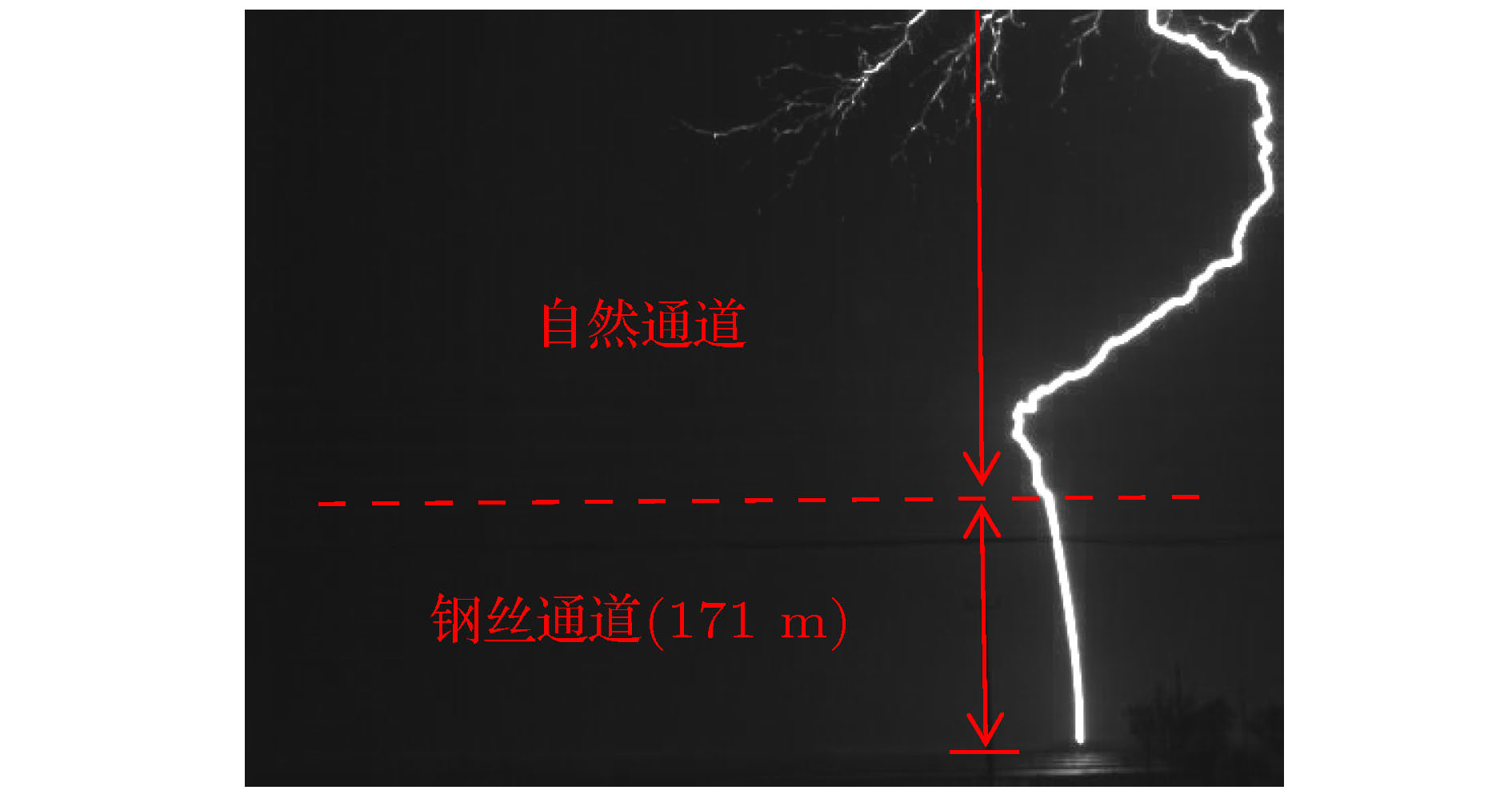
 下载:
下载:
